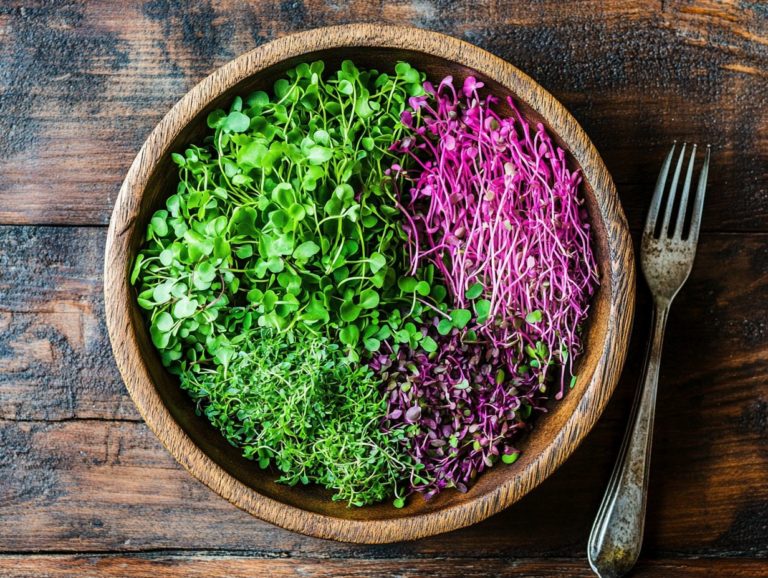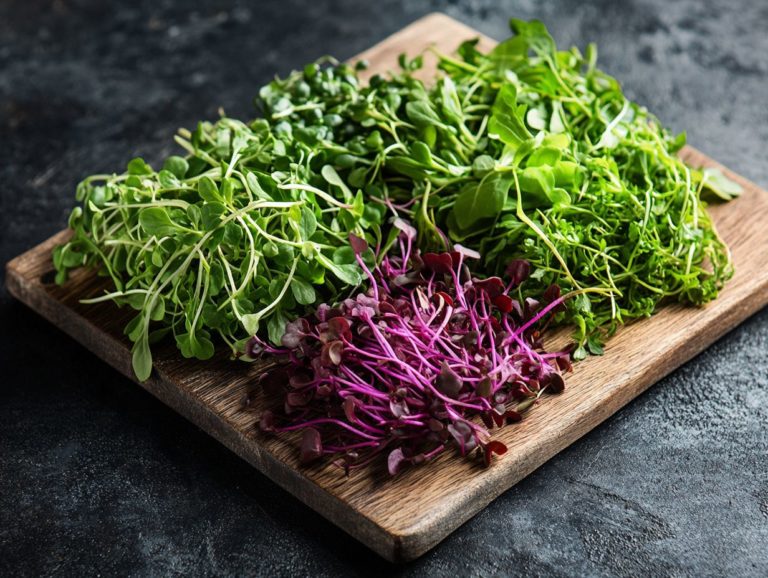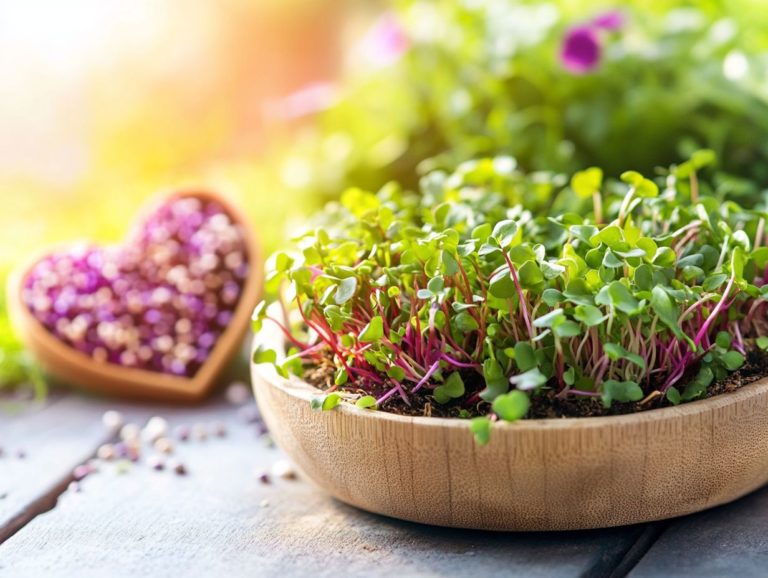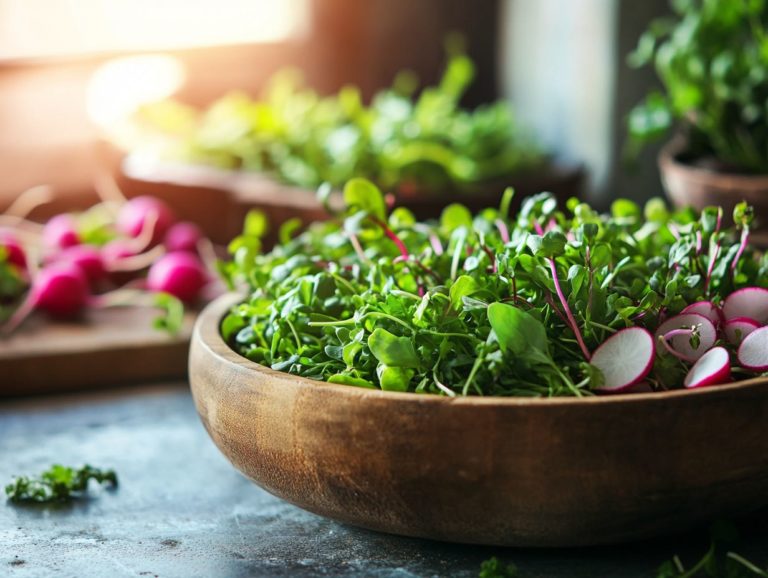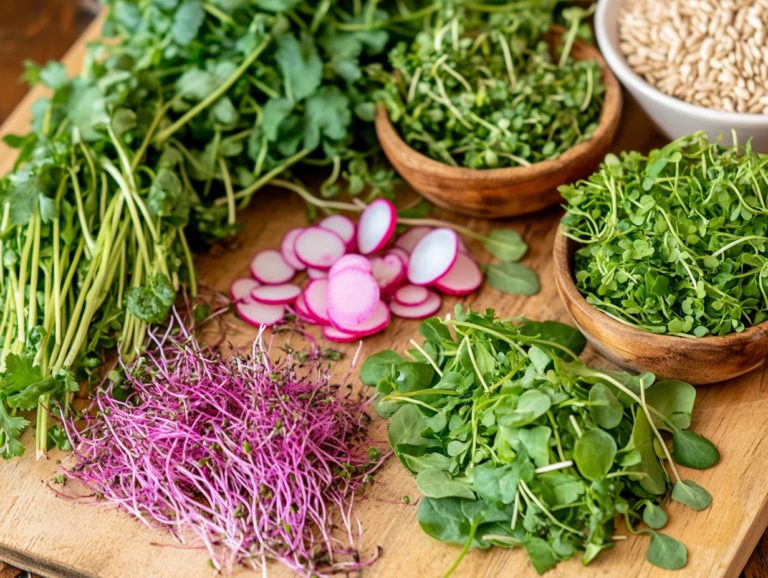5 Microgreens Rich in Antioxidants
Microgreens have taken the culinary world by storm, and it’s easy to see why. These petite greens offer a remarkable nutritional punch, brimming with antioxidants and vibrant flavors that can elevate any dish.
You ll discover five exceptional microgreens Broccoli Microgreens, Red Cabbage, Pea Shoots, Kale Microgreens, and Radish that are delicious and packed with health benefits. Their nutrient-dense profiles make them an ideal choice for a healthy diet.
You ll learn what distinguishes microgreens from sprouts, dive into their impressive health advantages, and gain insights on how to seamlessly incorporate them into your meals. Plus, you’ll find tips for growing microgreens at home.
Get ready to take your cooking to the next level with these tiny nutritional powerhouses! Let s dive in!
Contents
Key Takeaways:
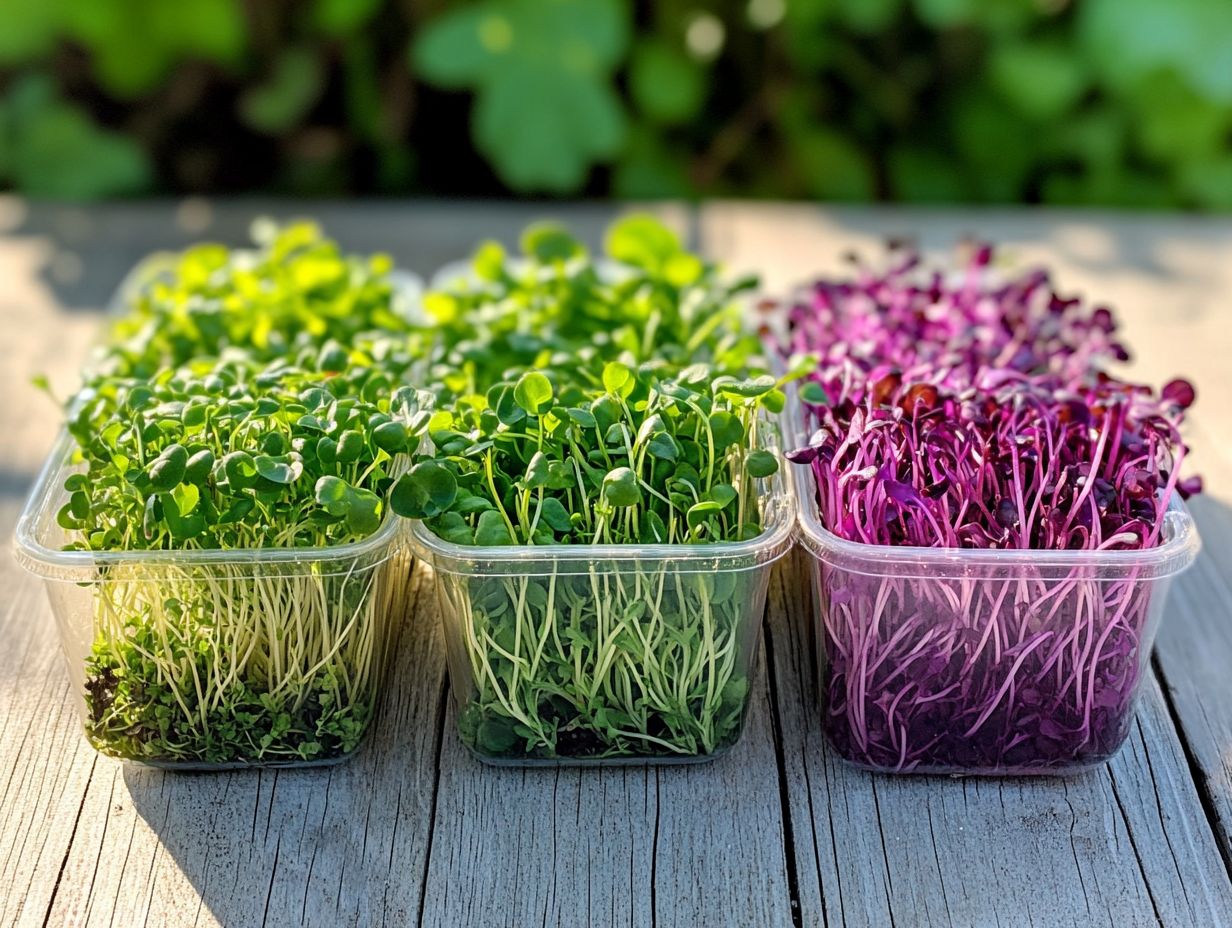
Here s why microgreens deserve a spot on your plate:
- Broccoli microgreens are rich in antioxidants that can help protect against chronic diseases and improve overall health.
- Red cabbage microgreens are a nutrient-dense source of antioxidants, including polyphenols and anthocyanins, which can aid in reducing inflammation and preventing chronic diseases.
- Pea shoot microgreens contain high levels of antioxidants, such as carotenoids and tocopherols, which can protect cells from damage and boost the immune system.
1. Broccoli Microgreens
Broccoli microgreens are young vegetables that you ll want to celebrate for their remarkable nutritional benefits. Packed with a nutrient-dense profile, they often outshine their mature counterparts. This makes them a valuable addition to any plant-based diet focused on enhancing health and wellness.
Originating from the Brassica oleracea species, these microgreens catch the eye not just for their great in different dishes but also for their powerful health-promoting properties. The best part? Growing them is a breeze. They thrive in soil or hydroponic systems and require minimal time to cultivate typically just 7 to 14 days before they re ready for your plate.
Research from reputable institutions like the Cleveland Clinic has spotlighted the specific health benefits these greens offer, linking them to cancer prevention and metabolic support. Their rich content of sulforaphane, a compound that helps detoxify the body, makes them especially effective against oxidative stress, as detailed in unlocking the antioxidant power of microgreens.
Studies show that nutrients in broccoli microgreens may help individuals with insulin resistance and Type 2 diabetes, highlighting their potential role in improving overall health.
2. Red Cabbage Microgreens
Red Cabbage Microgreens are not just a feast for the eyes; they are bursting with antioxidants and polyphenols, vital substances in the fight against cancer and the promotion of overall well-being.
With their slightly peppery and earthy flavor, these microgreens bring a delightful crunch to your salads, sandwiches, and wraps, enhancing both taste and nutritional value. Their unique flavor profile makes them a versatile addition to an array of dishes, from tacos to grain bowls. You’ll find that Red Cabbage Microgreens are rich in sulforaphane, a compound that holds promise in helping to prevent neurodegenerative diseases and promoting brain health. Additionally, incorporating microgreens that help lower blood pressure can further support your overall wellness.
By incorporating these vibrant microgreens into your balanced diet, you can support heart health and boost your immune system. They are an excellent choice for anyone looking to elevate their culinary experience while enjoying substantial health benefits.
3. Pea Shoot Microgreens
Pea Shoot Microgreens are a delightful addition to your salads and sandwiches, offering a burst of nutrients that elevate your healthy eating journey and provide essential components of plant-based foods.
These tender shoots, cultivated from green pea seeds, thrive in a moist environment with plenty of light, allowing them to grow swiftly within 7 to 14 days. Not only do they bring a crisp texture and a subtly sweet flavor that enhances your dishes, but they also serve as a powerhouse of nutrition, rich in vitamins A, C, and K, along with essential minerals like iron and calcium.
By incorporating these microgreens into your meals, you not only elevate your culinary experience but also make a significant contribution to your overall health, supporting immune function and promoting strong bones.
In conclusion, microgreens offer a flavorful and nutritious addition to various dishes. Try incorporating them into your meals for a boost of flavor and health!
4. Kale Microgreens
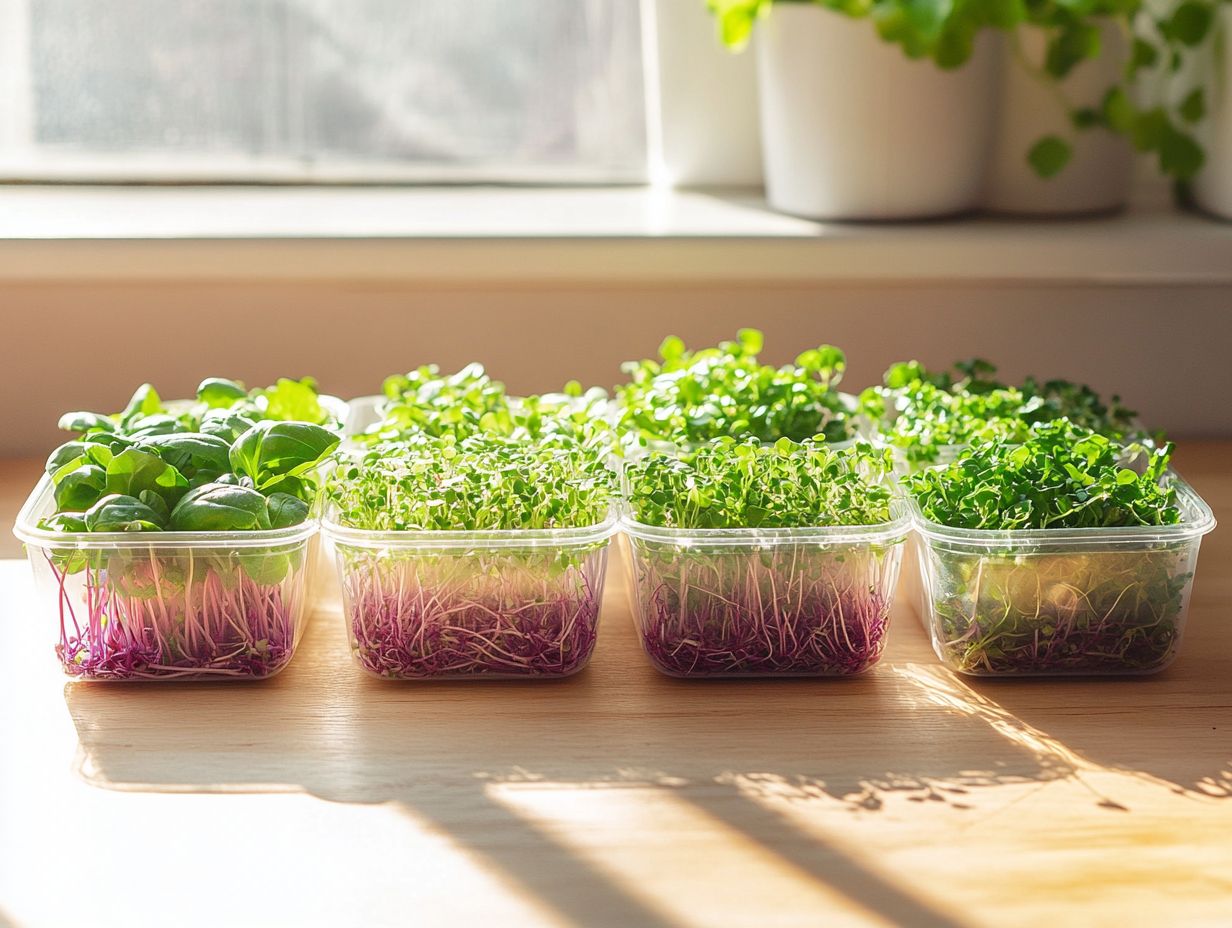
Kale Microgreens are young vegetables packed with nutrients, offering exceptional benefits that may help reduce the risk of heart disease and other chronic conditions.
These tiny powerhouses offer a punch of essential vitamins like A, C, E, and K, along with critical minerals such as calcium and magnesium. They play a vital role in maintaining cardiovascular health. Vitamin K is particularly important for promoting healthy blood clotting and regulating calcium levels in your arteries, which helps prevent arterial calcification.
The high levels of antioxidants in Kale Microgreens, including sulforaphane, help combat oxidative stress and potentially lower inflammation, a key factor in heart disease. They also help improve insulin sensitivity, which supports balanced blood sugar levels. For those looking for a nutritional boost, these nutrient-rich greens, along with other options, can be found in the top 10 microgreens for nutritional boost, making them a valuable ally in the fight against insulin resistance.
5. Radish Microgreens
Radish microgreens bring a unique flavor profile that adds a delightful spicy kick to your dishes while delivering substantial nutritional benefits. Packed with antioxidants, these tiny greens are a fantastic ally for your overall health.
Often used as a garnish or key ingredient in salads, sandwiches, and smoothies, microgreens contain elevated levels of vitamins and minerals that may play a role in cancer prevention. Emerging research highlights that the compounds in these microgreens can help thwart the growth of cancerous cells, thanks to their potent phytonutrients—natural compounds in plants known to promote health. For a nutritious start to your day, consider exploring the top 5 microgreen varieties for breakfast.
The remarkable nutrient density of radish microgreens is believed to bolster cognitive function, enhancing your brain health.
Don’t miss out on the chance to add these vibrant microgreens to your meals! You re not just elevating the flavor; you re also investing in your long-term health and mental clarity.
What Are Microgreens and How Are They Different from Sprouts?
Microgreens are young vegetables that you can harvest at an early stage, setting them apart from sprouts, which are simply germinated seeds. Both offer unique culinary and nutritional advantages, yet they differ significantly in growth, flavor, and nutrient density compared to their fully matured counterparts.
While sprouts typically require only a few days to grow and are enjoyed in their early form, microgreens take about one to three weeks to develop. They are harvested just after the first true leaves appear. This extra growth period allows microgreens to accumulate a richer, more concentrated flavor and enhanced nutritional benefits, making them favorites among chefs and health enthusiasts.
These vibrant greens come from various plant families, including Brassicaceae, which features favorites like arugula and radish, as well as herbs such as basil and cilantro. By integrating 7 microgreens packed with vitamins into your meals, you not only elevate the taste but also infuse your dishes with essential vitamins and minerals, promoting overall health and wellness.
What Are the Health Benefits of Eating Microgreens?
Eating microgreens offers a wealth of health benefits, from boosting nutritional density to providing powerful antioxidants that support cancer prevention and help combat insulin resistance.
These tiny greens are not just a garnish; they are brimming with essential vitamins and minerals, playing a vital role in your overall well-being. Renowned registered dietitian Kayla Kopp emphasizes that incorporating microgreens into your diet can significantly lower the risk of chronic diseases like heart disease and Type 2 diabetes. In particular, consider adding 5 microgreens that aid in digestion for added health benefits.
Their impressive concentration of phytochemicals enhances heart health by reducing bad cholesterol levels and promoting blood sugar regulation. This makes microgreens, including 5 unique microgreen varieties for exotic flavors, an invaluable addition to your meals, elevating your culinary experience while fostering a healthier lifestyle.
How Can Microgreens Be Incorporated into Meals?
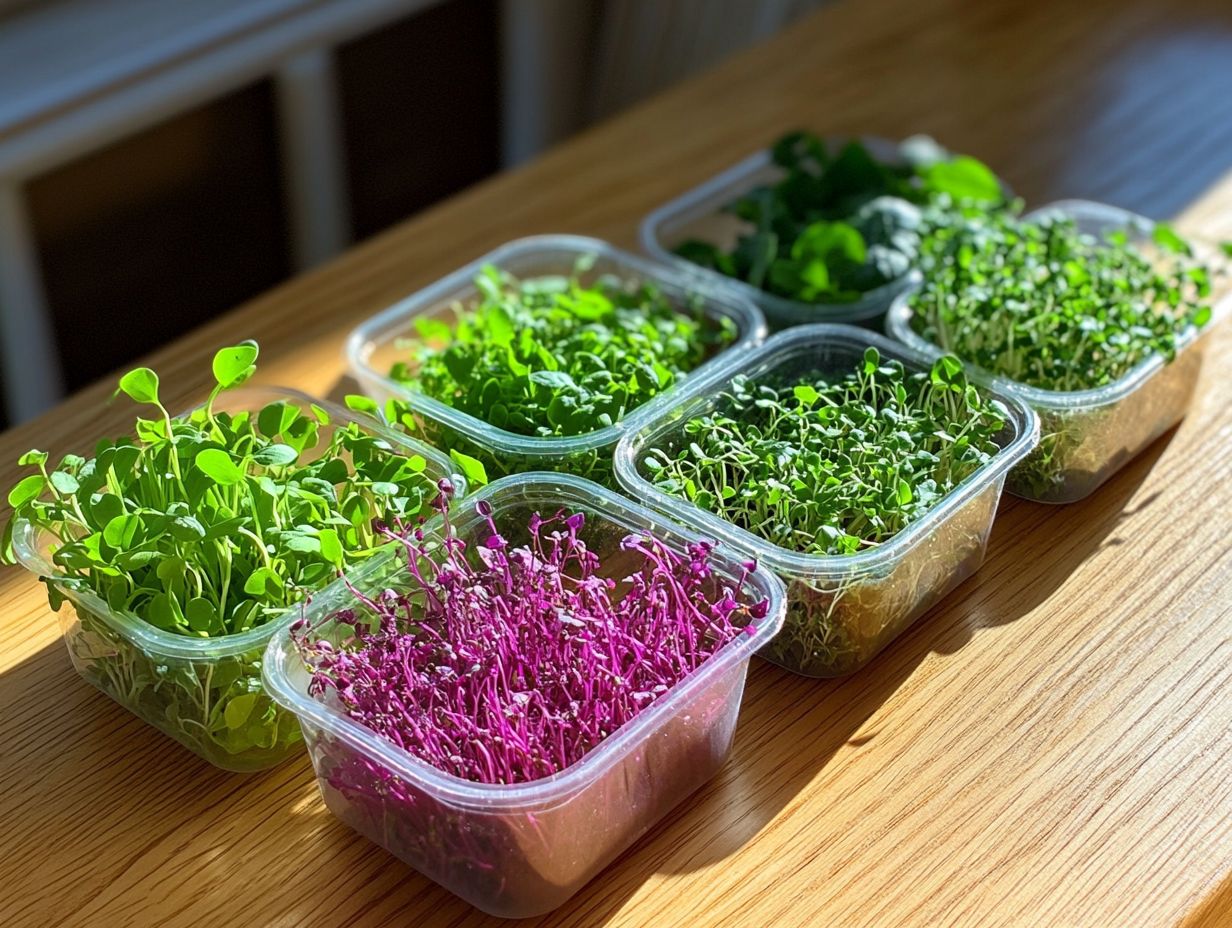
Incorporating microgreens into your meals is a fantastic way to elevate your nutritional intake, allowing you to enhance flavors and textures while maintaining a healthy, plant-based diet.
These petite greens pack a powerful punch of vitamins and minerals, making them an exceptional addition to any dish. For instance, when you toss a handful of microgreens into a fresh salad, you add a delightful crunch and vibrant color, significantly boosting the dish’s nutritional benefits. Consider incorporating 5 microgreens to boost energy levels for an extra health kick.
If you re a sandwich aficionado, layering microgreens can provide a refreshing twist, enhancing the overall taste without overshadowing the other ingredients. You can also blend them into your smoothies to ramp up the nutrient content and introduce an intriguing flavor dimension. You can even saut them lightly for a warm, savory element in cooked dishes.
Are There Any Precautions to Take When Consuming Microgreens?
While microgreens are celebrated for their impressive health benefits, it’s essential to take certain precautions to ensure your safety and maximize their nutritional benefits.
One of the primary concerns is the risk of harmful bacteria. These delicate plants can harbor bacteria if they aren t grown and handled with care. That’s why it’s crucial for you to source these greens from reputable suppliers who prioritize hygiene and quality control. Certain groups, such as individuals with compromised immune systems, pregnant women, and the elderly, should exercise extra caution when adding microgreens to their diets.
By being mindful of these safety practices, you can fully enjoy the vibrant flavors and rich nutrients of microgreens while minimizing any associated risks.
What Are the Different Types of Microgreens?
You ll discover a diverse range of microgreens, each belonging to different plant families and bringing unique flavors and nutritional profiles to elevate your diet.
Among the popular varieties, Kale stands out with its robust flavor and impressive nutrient density, brimming with vitamins A, C, and K. Then there are Broccoli microgreens, known for their mild taste and remarkable levels of sulforaphane, a compound that may help fight cancer. Additionally, incorporating the top 5 microgreens for smoothies can further enhance the nutritional benefits of your drinks.
Red Cabbage not only adds a vibrant splash of color to your plate but also packs potent antioxidants that help combat oxidative stress in your body. Let’s not forget Pea shoots, renowned for their sweet, succulent taste and generous fiber content, making them a delightful and nutritious addition to your salads and sandwiches. For an extra boost, consider incorporating nutritious microgreen varieties into your smoothies.
How Can One Grow Their Own Microgreens at Home?
Growing microgreens at home is not just an accessible gardening venture; it s a rewarding experience that gives you the power to cultivate your own vegetable seeds efficiently, all while providing fresh produce for your meals.
This project sparks creativity. It also helps you connect with nature. To embark on this journey, gather essential materials like seed trays, potting soil, and a selection of seeds such as arugula or sunflower.
For optimal germination, find a warm, well-lit space. Avoid direct sunlight and maintain temperatures between 65 F and 75 F. Regular misting will help keep the soil moist and happy.
When your microgreens reach about 2-3 inches in height, they re ready for harvest, adding a crisp, nutritious touch to your salads and sandwiches. Embracing home gardening not only cuts down on food waste but also elevates your well-being, delivering essential nutrients that contribute significantly to a healthy diet.
Frequently Asked Questions
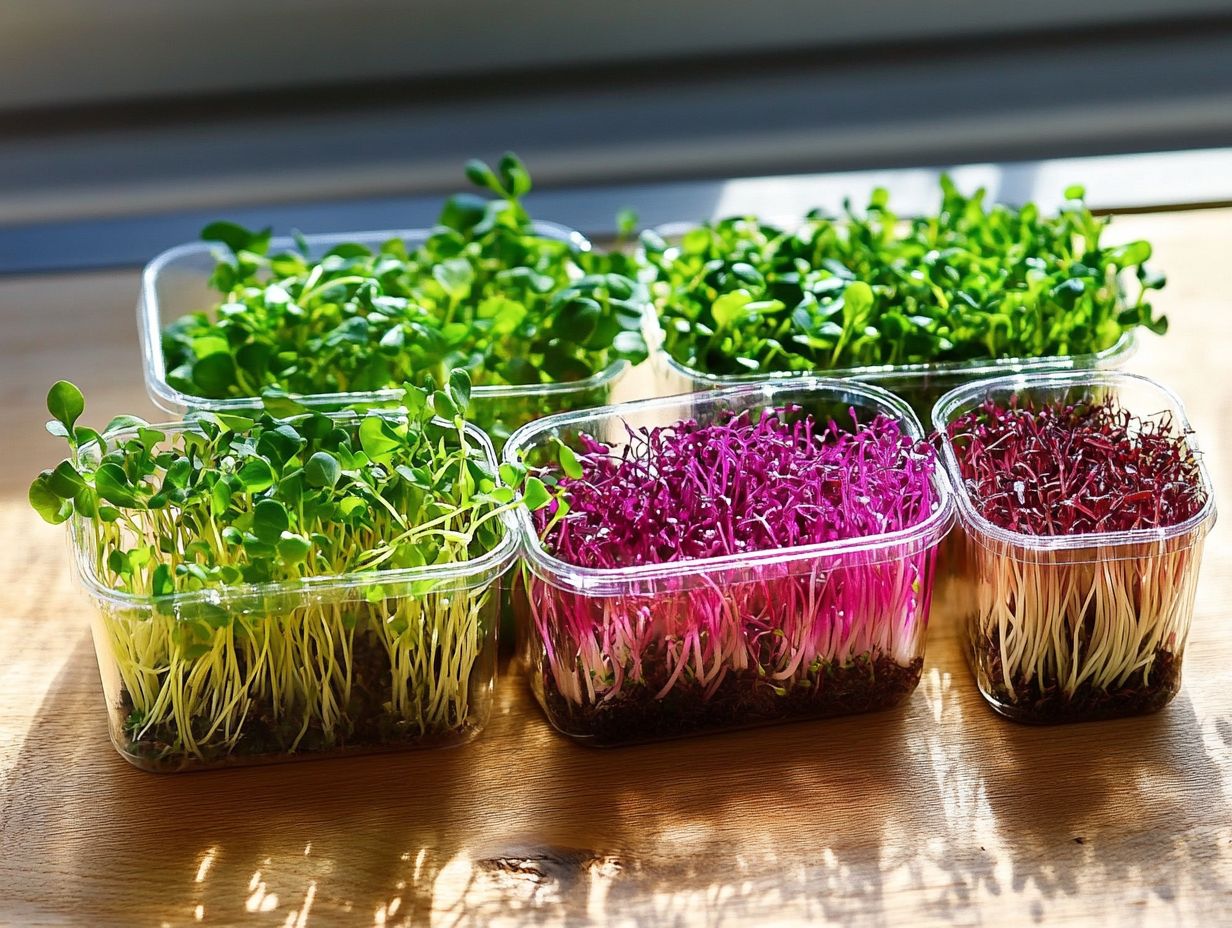
Curious about microgreens? Here are some frequently asked questions to help you learn more!
What are the top 5 microgreens that are rich in antioxidants?
The top 5 microgreens that are rich in antioxidants are kale, broccoli, red cabbage, radish, and cilantro.
Why are microgreens high in antioxidants?
Microgreens are harvested at an early stage of growth. At this point, their nutrients, including antioxidants, are most concentrated.
How do antioxidants benefit our health?
Antioxidants protect our cells from damage caused by harmful molecules called free radicals. This damage can lead to chronic diseases, but antioxidants can neutralize these threats.
Can we easily add microgreens to our diet?
Absolutely! Microgreens can be included in salads, sandwiches, smoothies, or as a garnish on various dishes. They re an easy way to boost your antioxidant intake.
Are microgreens rich in other nutrients as well?
Yes, they also contain vitamins, minerals, and fiber. Including them in your diet can improve overall health.
How should we store microgreens to keep their nutrients?
Store microgreens in a cool, dry place. To maintain their antioxidant content, avoid washing them until you’re ready to use them. Keep them in an airtight container in the refrigerator.

